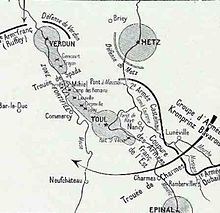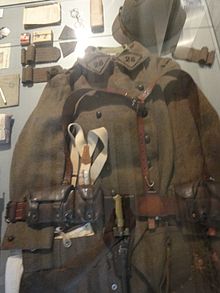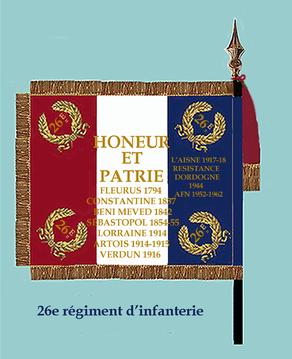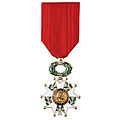26 e régiment d'infantry
|
26 e regiment d'infanterie |
|
|---|---|
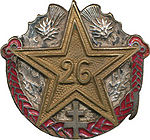 |
|
| active | 1776 to 1998 |
| Country |
|
| Armed forces |
|
| Armed forces | infantry |
| Type | regiment |
| Location | Nancy |
| Patron saint | Saint-Maurice d'Agaune |
| motto | "Qui s'y frotte, s'y pique" |
The 26th e régiment d'infanterie was an infantry regiment, set up in 1776 as the Régiment de Bresse in the Kingdom of France and in service during the Ancien Régime and then with a few interruptions until it was dissolved in 1998. Before the unification by the numbering created in the Revolution, it was last the name of the province of Bresse .
Lineup and significant changes
- 1776: The Régiment de Poitou was split up, the 1st and 3rd Battalion fell in love as the "Régiment de Pouitou" with a flag and uniform on duty; the "Régiment de Bresse" was set up from the 2nd and 4th battalions.
- January 1, 1791: All regiments were only designated with numbers, the "Régiment de Bresse" was now called "26 e régiment d'infanterie de ligne (ci-devant Bresse)".
Break of the line of tradition
In the course of the premier amalgam , the regimental association was dissolved and not reunited.
The 1st Battalion was together with the
- 3 e battalion de volontaires des Hautes-Alpes
- 5 e bataillon de volontaires des Hautes-Alpes
to the “51 e demi-brigade de bataille”.
The 2nd Battalion was together with the
- 2 e battalion de volontaires du Vaucluse
- 5 e bataillon de volontaires des Bouches-du-Rhône
- 2nd e battalion des réquisitionnaires de la Montagne d'Aix
to the “52 e demi-brigade de bataille”.
This ended the tradition of the regiment - there was no 26th infantry regiment between 1794 and 1803 - until it was continued in 1803 with a newly formed 26 e régiment d'infanterie de ligne.
- 1803: A new "26 e régiment d'infanterie" de ligne was built.
- 1814: During the Restoration and the rule of the Hundred Days , the regiment kept its number.
- July 16, 1815: The regiment in Saint-Genest was disbanded with the entire Napoleonic army after the king's second return .
- August 11, 1815: Establishment of the 55 e Légion du Morbihan
- 1820: Renaming of the "Légion du Morbihan" to 26 e régiment d'infanterie de ligne
- 1830: By order of September 18, a fourth battalion was set up. From then on the regiment had a staff of 3,000 men.
- 1870: In the Franco-Prussian War , a marching regiment was set up, which was named 26 e régiment de marche .
- 1871: After the fall of the regiment during the war, the marching regiment was transformed into the 26th e régiment d'infanterie de ligne .
- 1882: Renaming to 26 e régiment d'infanterie
- 1914: During the mobilization, the reserve regiment , the "226 e régiment d'infanterie", was set up.
- 1998: dissolution
Mestres de camp / Colonels
Mestre de camp was from 1569 to 1661 and from 1730 to 1780 the denomination of rank for the regiment holder and / or for the officer in charge of the regiment. The name "Colonel" was used from 1721 to 1730, from 1791 to 1793 and from 1803 onwards.
After 1791 there were no more regimental owners.
Should the Mestre de camp / Colonel be a person of the high nobility who had no interest in leading the regiment, the command was given to the “Mestre de camp lieutenant” (or “Mestre de camp en second”) or the Leave a colonel lieutenant or colonel en second.
- April 26, 1776: Léon-Eugène, comte de Maulde
- August 7, 1778: Alexandre-Guillaume de Gallard de Béarn, comte de Brassac
- March 10, 1788: François-Pierre-Olivier de Rougé, comte de Plessis-Bellière
- July 25, 1791: Pierre-Paul-Antoine de La Guette de Vernon
- September 30, 1792: Jean-Pierre-Maurice de Rochon
(...)
- 1803: Colonel Guillaume Miquel
- 1808: Colonel Pierre Barrère
- 1810: Colonel Annet Morio de L'Isle
- 1810: Colonel Pierre Étienne Fabry
- 1811: Colonel Marie Stanislas Prévost
- 1813: Colonel Jacques Louis Dornier
- 1815: Colonel Louis Joseph Hugo
- 1844: Colonel Élie-Frédéric Forey
- 1856-30. January 1860: Colonel Denis Benjamin de Sorbiers
(...)
- 1870-1875: Colonel Hanrion
- 1875-1881: Quenot
- 1881–1886: Breugnot
- 1886-1890: Joly
- 1890-1892: Belladen
- 1892-1894: Goulon
- 1894-1895: Dillon
- 1895-1900: Kolb
- 1900: toboggan
- 1900-1904: Vautier
- 1904–1907: Goepp
- 1907-1910: Sibille
- ? : Colonel Robert Boissau
- 1910–1914: Colonel Paul-François Grossetti
- 1914: Colonel Gaston d'Armau de Pouydraguin
- 1914: Ungerer
- 1914: Savary
- 1914-1915: Colin
- 1915–1917: Henri Salles
- 1917-1918: Vergnes
- 1918: Morel
- 1918-1919: Braun
- 1919-1920: Meulle Desjardins
- 1920-1921: Guillaume
- 1921–1923: Spitz
[...]
- 1940: Colonel Didierjean
[...]
- 1964–1966: Colonel Jacques-Philippe Dehollain
- 1966–1968: Colonel Roger Pichené
- 1968–1970: Colonel René Xhaard
- 1970–1972: Colonel Christian d'Arbonneau
- 1972-1974: Colonel Capelle
- 1974–1976: Lieutenant-Colonel Jaujard
- 1976–1978: Lieutenant-Colonel Pierre Pauvert
- 1978: Lieutenant-colonel Bescondl
Peace time
In July 1775 the regiment left Verdun and moved to Saarlouis , in July 1776 to Saint-Omer. In 1778 it moved into quarters in the area of Quimper in Brittany . In the same year it moved back to Verdun, in April 1782 to Metz, in October of the same year to Thionville, in May 1783 to Saarlouis, in October of the same year to Le Havre, in June 1785 to Brest, in April 1788 to Toulouse and in November of the same year to Montpellier .
In 1790, the 2nd Battalion was in Uzès, where it was accused by the local patriots of a lack of citizenship and that it preferred to listen to the sermons of the priests. It was then removed from the city and relocated first to Alès and then to Pont-Saint-Esprit , where it was reunited with the 1st Battalion. Both battalions then marched to Draguignan , where they arrived in April 1791. After a short stay the regiment was ordered to Toulon and shipped there to Bastia , which they reached on May 19th. In December 1792, details were put together to accompany Admiral Laurent Truguet on the expedition to Sardinia.
Battle calendar
Divisions were deployed as marines on ships of the Navy, so a company was embarked on the frigate Belle Poule . With this the company took part in the naval battle on July 15, 1780 against the British 64-gun ship of the line HMS Nonsuch . The "Belle Poule" was attacked by the British, the Détachement des 26 e RI had 5 dead and 14 wounded.
Wars of the Revolution and the First Empire
- 1793 : Campaign against the insurgents of Pasquale Paoli in Corsica . On June 3, the unit was able to distinguish itself in the battle near Calvi . During the Battle of Farinole , the monastery was occupied by Marianda. One detachment was captured by the British on February 17, 1794 in the defense of Saint-Florent and was brought to Gibraltar .
Between 1794 and 1803 there was no 26 e régiment d'infanterie.
- 1803 and 1804 : The unit was in Paris and belonged to the reserve of the field army.
- 1804 to 1814 : A battalion was stationed in the Caribbean and fought the revolution in Haiti . It was Roseau on Dominica ingested.
- 1807 : Delegation to the observation corps on the Gironde
- 1808 : Deployment in Portugal and Spain during the Napoleonic Wars on the Iberian Peninsula . Occupation of Beja (Portugal) , Evora, Rorissa and use in the Battle of Vimeiro .
- 1809 : Battle of Braga , Second Battle of Oporto
- 1810 : Battle of Buçaco
- 1811 : Occupation of Sabugal and Almeida , battle of Fuentes de Oñoro
- 1812 : Battle of Salamanca , Siege of Ciudad Rodrigo
- 1813 : Battle of Bidassoa , occupation of the Citadel of Pamplona , Pont de Berra and Bayonnette, Battle of Lützen , Battle of Bautzen , Battle of Dresden and Battle of the Nations near Leipzig
- 1814 : Rhine crossing at Bingen , battle at Fère-Champenoise in Bayonne
- 1815 : Châtillon, battles against the royalists in the Vendée and against the Chouannerie , battle near Échaubrognes
Officers of the regiment wounded or killed between 1808 and 1814:
- fallen: 17
- died of her wounds: 10
- wounded: 78
- 1822 to 1823 : French invasion of Spain
- 1832 : Campaign in Belgium
- 1837 to 1844 : Campaign in Algeria
Crimean War
Participation in the siege of Sevastopol . Heavy losses were recorded during an attack on June 18, 1855 - 157 men were killed and 357 wounded. With the "Autemarre Division" it marched into the fortress on September 8th and occupied the Bastion du Mât. In the months that followed, the unit conducted minor skirmishes against Russian troops at Corbon-bell and Yeni Sala.
- In 1856 the regiment was stationed in Montélimar , two companies were in Privas . From there the unit moved to Valence and then to Lyon in the autumn of 1858 . Then came the command to Paris with accommodation in the Caserne de Popincourt and then in the Fort d'Ivry and in the Fort de Bicêtre
Sardinian war
During the Sardinian War, the regiment was assigned as an experimental unit, to be quickly relocated by rail in the event of mobilization. The transport led to Melun , where the regiment remained for several weeks. It was then assigned to the 2nd Division of Général Uhrich in the 5th Corps of Jérôme Napoléon and transported by ship to Livorno, where it was set ashore on May 24, 1859. It was then used in the occupation of the duchies of Tuscany , Modena and Parma . On June 26th it marched north to unite with the other corps at Villafrance and to supervise the conclusion of the peace treaty ( preliminary peace of Villafranca ).
During the following year the regiment remained stationed in Bergamo. On May 16, 1860, it returned to France. Here it was stationed one after the other in the Dieppe , Eu and Le Tréport region .
Franco-Prussian War and Paris Commune
On August 1, 1870, the "26th e régiment d'infanterie" was assigned to the Armée du Rhin .
With the 25 e d'régiment infantry under the command of Colonel Gibon formed the unit, the 1st Brigade of General de Marguenat. The 1st and 2nd Brigade (Général Comte de Chanaleilles) with 3rd field artillery batteries and a pioneer company formed the 4th Infantry Division under Général de division Levassor-Sorval. The division was part of the 6th Army Corps of Maréchal Certain-Canrobert.
- Use in the battle of Bellevue
The 2nd depot company of the regiment, 1st officer, 216 NCOs and men, was assigned to the 16 e régiment d'infanterie de ligne .
- The 4th battalion was assigned to the "15 e régiment de marche" (15th marching regiment ) and fought with this on September 19, 1870 in the battle near Châtillon .
- The 8th companies of the 2nd and 3rd battalions of the regiment fought in the "29 e régiment de marche" in the Loiret department in the battles near Chilleurs-aux-Bois , Ladon , Boiscommun , Neuville-aux-Bois and Mézières-en- Gâtinais .
The regiment was involved in the suppression of the Paris Commune (Bloody Sunday).
1871 to 1914
- From October 1, 1887 to 1914, the regiment was stationed in Nancy . It belonged to the 11th Division, called: " Division de fer " (Iron Division), consisting of the 26 e RI, 37 e RI , 69 e RI and the 79 e RI , which was assigned to secure the French eastern border.
First World War
The regiment was subordinate to the 11th Infantry Division from August 1914 to November 1918. When war broke out, it was stationed at the Thiery barracks in Nancy and Toul
1914
From July 31st to August 12th the regiment was deployed to cover the border near Seille (Mosel) . There were no major activities during this period. There were some skirmishes, but no casualties, only a non-commissioned officer of the Bavarian Chevaulegers was taken prisoner by the French.
On August 14 was the 26 e RI of the 2nd Army, which launched an offensive against the German front line
On August 16, the 11th Infantry Division with the 26 e RI was able to repel a German counterattack near Mörchingen . A division under the command of Capitaine Penancier succeeded in stealing the luggage of the regimental commander of the 137th Infantry Regiment, 16 ammunition wagons and a tool wagon as well as the horse harness that went with it. In addition, 115 prisoners were taken, including three officers. The division then withdrew, but was not pursued by the Germans.
On August 22nd, the 11th Division on the Meurthe had withdrawn as far as Saint-Nicolas-de-Port and Rosières-aux-Salines . However, the Germans were more interested in the capture of Nancy, occupied Lunéville and concentrated their forces on the Trouée de Charmes , the interface between the 1st and 2nd French armies.
On August 25, the regiment stood out as it was able to successfully defend the Ferme de Léomont against the attacks of the 2nd Bavarian Reserve Corps with heavy losses.
- September 9: Battle at Vitrimont
- Battle of the Marne
- Race to the sea
- First Battle of Flanders
1915
Participation in the offensive in Artois .
- September 28th to November 6th: Autumn battle in Champagne
- Winter battle in Champagne
- Attack on the Butte du Mesnil on September 25th and 30th
1916
Participation in the
1917
In April and May trench warfare at the Chemin des Dames .
1918
Attack battles on the Aisne, Cutry , Fosse-en-Bas (June 28), capture of the heights of Pernant (July 18) and battle near Nazareth.
Interwar period
The top of the regiment's flagpole was decorated with the Legion of Honor on July 5, 1919.
Second World War
On May 16, 1940, the regiment received the order, reinforced by a tank company and a Polish anti-tank platoon near Choisy , to build a bridgehead on the north side of the Aisne. The Compiègne river and forest were to be defended here. On May 20, 1940, a battalion of the "141 e régiment d'infanterie alpine" (141st Mountain Infantry Regiment) was subordinated to the regiment. It had come from Meaux and was supposed to protect the bridges at Compiègne, Choisy-au-Bac , Francport and Rethondes . Nothing happened until June 5th. On the night of June 6-7, the French forces withdrew from Noyon and the 11th Division was suddenly in the forefront. On June 7th the order was given to blow up the bridge at Choisy-au-Bac. The order was carried out at 10:00 p.m. On Sunday, June 9th, at 7:00 p.m., the Germans appeared outside Choisy. An enemy patrol was captured by the Poles. Then more German soldiers appeared in the village without taking any further action. A Polish patrol took boats across the river and gathered at the entrance to the church, where they came under infantry fire. Only the aspirant Jalony was able to swim back to the French lines. The Germans could then be stopped by artillery fire. At 9:00 p.m. on June 10, the regiment finally withdrew and Choisy-au-Bac fell into the hands of the Germans. Several houses, including the rectory, burned down.
The regiment remained in the Vichy government's armistice army after the armistice of 1940 and was stationed in the Bergerac barracks . After the German invasion of unoccupied France ( Anton company ), the unit disbanded, the majority of the members went into the Resistance and here into the military arm, the Organization de résistance de l'armée (ORA) with the four groups im Dordogne-north, Périgueux-north, Périgueux-ville and Bergerac-Dordogne-sud. On November 12, 1942, the latter consisted of 16 officers, 75 NCOs and 200 men.
post war period
In June 1954, the headquarters, the headquarters company and the 1st Battalion were given up to rebuild the 23 e RI .
Algerian war
The regiment was used with the 2nd Infantry Division in the Algerian War in the region around Constantine .
After the end of the war on March 19, 1962, the unit, like 91 others, was used to form the National Armed Forces. The basis was the Treaty of Évian of March 18, 1962. The 26 e RI set up the 411 e UFL-UFO (UFL = Union des forces locales - UFO = Unions des forces de l'Ordre ) of the armed forces of the provisional Algerian government. The unit consisted of 10% military personnel from the metropolitan areas and 90% of military personnel with rural roots (Militaires musulmans) . In 1963 the unit returned to France.
post war period
Until the mid-1970s, the regiment was stationed in the Drouot barracks in Vandœuvre . During this time, the unit was set up as a regiment and only had a permanent crew of active soldiers.
In the event of mobilization, the 26 ° RI was intended as a shock regiment with the addition of "de commando" to its name. It consisted of three combat companies, a staff and support company and a training company. Each of the combat companies consisted of three combat platoons and an army support platoon with two recoilless M40 guns on Jeep Hotchkiss M201 and two pulled mortars 81 mm.
The unit was then converted into an inactive reserve regiment and provided only one tribe for the Technical Command Training Center (Center d'entraînement aux techniques commando) in Pont-Saint-Vincent . A new association badge was issued for this purpose. The training center with the number 8 was closed in 1997, the "26 e régiment d'infanterie de réserve" dissolved the following year.
Regimental flag
On the back of the regimental flag (since Napoleonic times) the campaigns and battles in which the regiment took part are listed in gold letters.
- Last regimental flag used
Awards
The flag ribbon is decorated with the Croix de guerre 1914–1918 with six palm branches for six honorable mentions in the army command. On July 5, 1919, the regiment was awarded the cross and the Fourragère in the colors of the Légion d'honneur . It was also awarded the gold medal of the city of Milan for participating in the Battle of Solferino .
The members of the regiment have the right to wear the Fourragère in the colors of the Légion d'honneur (even if they are re-established).
Motto
(Anyone who messes with him will feel the tips of his weapons)
Personalities who served in the regiment
literature
- 26e regiment d'infanterie, historique du corps. Service historique de la Défense , 4 M 34.
- Jean-Marie Déguignet: Histoire de ma vie. An Here, Plougastel-Daoulas 2000, ISBN 978-2-86843-226-1 ( limited preview in Google book search).
- Henri Salles: Historique du 26 e régiment d'infanterie pendant la Grande Guerre 1914-1918. Berger-Levrault, Nancy 1919 ( digitized on Gallica ).
- Général Serge Andolenko : Recueil d'historiques de l'infanterie française. Eurimprim, Paris 1969.
Web links
- Three excerpts from the report of a member of the regiment under Napoléon III:
- La prize de Sébastopol, 8 septembre 1855 ( Memento of 13 August 2007 in the Internet Archive ). In: Notrefamille.com
- La Guerre de Crimée. In: Imago Mundi
- Passage du Mont-Cenis en barque. 1860. In: Historial du Grand Terrier
- Maurice Landry: Un vétéran se rappelle ( Memento of September 11, 2006 in the Internet Archive ). In: La Boueille. November 12, 1980
Footnotes
- ↑ which had nothing to do with the old regiment
- ↑ Victor Louis Jean François Belhomme: Histoire de l'infantry en France. Volume 5. p. 151 ( digitized on Gallica ).
- ↑ Aristide Martinien: La guerre de 1870-1871. La mobilization de l'armée. Mouvement des dépôts (Armée active). Du 15 July 1870 au 1 er mars 1871. L. Fournier, Paris 1911, p. 69 ( digitized on Gallica ).
- ↑ Michaël Bourlet: L'armée de Versailles pendant la Semaine sanglante et les combats de rues (21-28 May 1871). .
- ↑ The Trouée de Charmes was the intentionally left gap in the defensive belt of the Barrière de fer between the fortress sections of Toul and Épinal. The German attackers were supposed to be wedged in and destroyed here.
- ^ Légion d'honneur. May 19, 1802 ( Memento of January 5, 2010 in the Internet Archive ). In: France Phaléristique .
- ↑ « Décision n ° 12350 / SGA / DPMA / SHD / DAT du 14 September 2007 relative aux inscriptions de noms de batailles sur les drapeaux et étendards des corps de troupe de l'armée de terre, du service de santé des armées et du service des essences des armées, Bulletin officiel des armées, n ° 27, 9 November 2007 »(German:“ Provision n ° 12350 / SGA / DPMA / SHD / DAT of September 14, 2007 on the appearance of the inscriptions on the flags and standards of the Troops of the army, the medical service and the fuel supply branch. Published with the official army bulletin No. 27 of November 9, 2007 ")
- ↑ " Arrêté relatif à l'attribution de l'inscription AFN 1952–1962 sur les drapeaux et étendards des formations des armées et services, du 19 novembre 2004 (A) NORDEF0452926A Michèle Alliot-Marie " (German: "Order AFN 1952–1962 on the assignment of the inscriptions on the flags and standards of the formations of the army and the services of November 19, 2004 (A) NORDEF0452926A Michèle Alliot-Marie ")
- ↑ This also applies to units that have already been disbanded, as they can (theoretically) be put back into active service at any time








